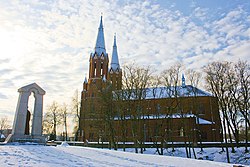Anykščiai
Anykščiai | |
|---|---|
City | |
 Anykščiai Church – the tallest church in Lithuania | |
| Coordinates: 55°32′N 25°6′E / 55.533°N 25.100°E | |
| Country | Lithuania |
| Ethnographic region | Aukštaitija |
| County | Utena County |
| Municipality | Anykščiai district municipality |
| Eldership | Anykščiai eldership |
| Capital of | Anykščiai district municipality Anykščiai eldership |
| First mentioned | 1442 |
| Granted city rights | 1516 |
| Population (2021) | |
| • Total | 8,495 |
| Time zone | UTC+2 (EET) |
| • Summer (DST) | UTC+3 (EEST) |
Anykščiai (ⓘ; German: Onikschten; see other names) is a ski resort town in Lithuania, 20 miles (32 kilometres) west of Utena.[1] The Roman Catholic Church of St. Matthias in Anykščiai is the tallest church in Lithuania, with spires measuring 79 metres (259 feet) in height. Anykščiai has a resort status in Lithuania and is a popular destination of domestic tourism.
Name[edit]
The name of the city is believed to be derived from the Lithuanian hydronym Anykšta.[2] Its name in other languages includes Polish: Onikszty; Russian: Они́кшты, romanized: Onikshty; Belarusian: Ані́кшты, romanized: Anikshty; Yiddish: אַניקשט, romanized: Aniksht; German: Onikschten.
History[edit]

Archeological research in the area has revealed settlements dating from the late Neolithic.
Anykščiai was first mentioned on 7 November 1442 as a possession of Grand Duke of Lithuania Kazimieras Jogailaitis.[3]
Its location on the Šventoji River, connecting it to the Baltic Sea via the Neris River and Nemunas River, contributed to its development. It also lay on a land route between the cities of Vilnius and Riga. Its strategic importance led to frequent assaults by the Teutonic Order. The first written mention of the town dates to 1442; its first appearance on a map is dated tentatively to about 1578.[4]
Anykščiai is a place where many Lithuanian poets and writers originated - Antanas Vienuolis, Antanas Baranauskas, Jonas Biliūnas. It is called Weimar of Lithuania for that reason. There are about 250 culturally and historically important places in Anykščiai and Anykščiai district - Anykščių šilelis, to which the poem The Forest of Anykščiai of A.Baranauskas was dedicated, Puntukas boulder, the Beacon of Happiness monument, canopy walkway, horse museum, manors and old Lithuanian fort hills shrouded in mystery and legends.

Prior to Lithuania re-establishing its independence after World War I, Anykščiai was part of the Kovno Governorate of the Russian Empire. A shtetl existed within the town, with a Jewish population of 2,754 in 1900.[5]
Wool processing facilities, a winery, and Lithuanian and Jewish schools were established after World War I, when its population reached about 4,000. During World War II, its bridges and city center were destroyed. In summer 1941, two mass executions of the local Jewish population occurred.[4] Around 1,500 Jews were murdered by German Nazis and their local collaborators.[6]

After the Soviet occupation, Anykščiai became a center of Aukštaitija partisans. Anykščiai district was the only one in Lithuania which belonged to 5 partisan military districts (apygarda) - Algimantas, Didžiosios Kovos, Vytis, Vytautas and to a third district of Northern Lithuania - Aukštaitija by the Lithuanian Freedom Army. In 2014 in Šimonių giria (The Šimoniai Forest) a cognitive route was created which leads through the places of the Algimantas military district partisan paths and places.[7]
Industry[edit]
Famous in Lithuania fruit winery Anykščių vynas, established in 1926 by Balys Karazija.
Notable natives and residents[edit]
- Jonas Juozapas Abelevičius, Lithuanian priest
- Antanas Baranauskas, poet, whose home is preserved in Anykščiai Regional Park.
- Jonas Biliūnas, writer
- Giedrius Titenis, swimmer
- Antanas Vienuolis, writer
- Bronė Buivydaitė, writer
- Sergejus Jovaiša, basketball player
Twin towns — sister cities[edit]
References[edit]
- ^ (in English) Skiing in Lithuania - Ski vacation in Lithuania
- ^ "Lietuvos miestų pavadinimų kilmė – tik upės ir pavardės?" [The origin of Lithuanian city names - only rivers and surnames?]. Delfi (in Lithuanian). 28 January 2012. Retrieved 29 September 2023.
- ^ Baranauskas, Tomas. Drumstas vanduo Anykščių istorijos ištakose, Lituanistica, 2022, nr. 3 (129), p. 250-253.
- ^ a b "History". Anykščiai district municipality. Archived from the original on 11 April 2011. Retrieved 16 December 2009.
- ^ JewishGen
- ^ "Holocaust Atlas of Lithuania". www.holocaustatlas.lt. Retrieved 24 January 2019.
- ^ Anykščiai laukia besidominčių partizanų kovomis: čia įrengtas naujas pažintinis maršrutas
- ^ "Anykščių miesto partneriai". anyksciai.lt (in Lithuanian). Anykščiai. Retrieved 1 September 2019.




